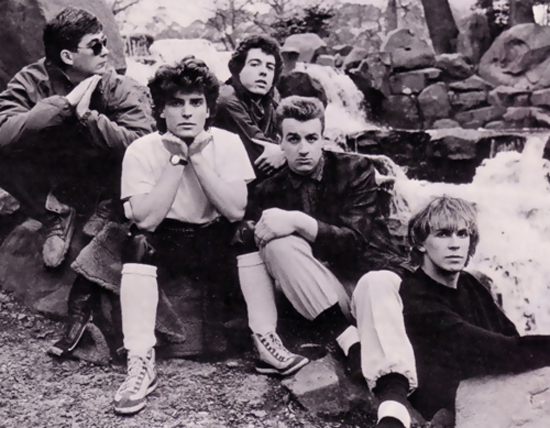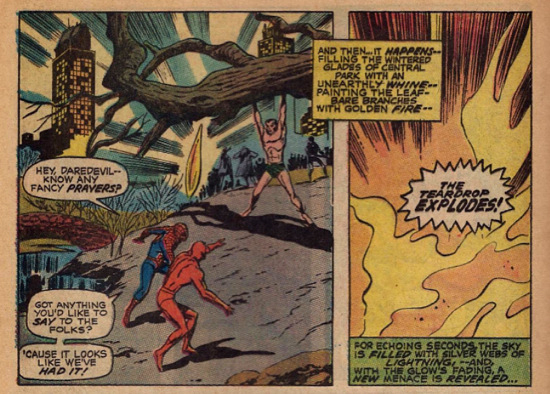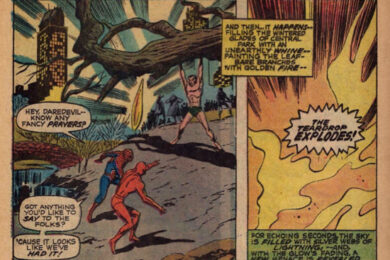The very first word bubble on the very first page of Daredevil Vol. 1 #77, …And So Enters the Amazing Spider-Man, reads "Like no other story in the Marvel Age of Comics… this one’s for you, sports fan–!" It could just as well have read "music fan". For it was this June 1971 issue that would give The Teardrop Explodes their name.
Fast-forward seven years, to September 1978.
The setting: 14 Rodney Street, Liverpool. Paul Simpson’s first floor bed-sit. "A hang-out and port of call for both the cool people and the crazies", as Julian Cope would later relate in his enormously entertaining autobiography, Head-On.
Simpson, original keyboard player in The Teardrop Explodes, found the comic in the basement, left behind by the previous tenant, local musician and actor, Ozzie Yue (Father Ted, Lara Croft: Tomb Raider, Nuns On The Run).
Yue says: "I lived there for three or four years when I was a hairy rock musician, a member of Supercharge. I don’t have a great recollection of the comics but they definitely could have migrated into the flat along with the NMEs, Melody Makers, Beat Instrumentals and Guitar mags (to say nothing of the Playboys and Mayfairs) that passed through during that time, either mine or other members of the band."
As noted on the last page of that Daredevil, "In this crazy world, fate sometimes takes a hand."
Paul Simpson says: "When Julian, Mick Finkler, drummer Dave Pickett and myself were discussing band names, I just happened to be idly flicking through the comic and was taken by the frame in the story that read something like ‘Suddenly over central park… The Teardrop Explodes’, suggesting it to the others. Mick and I were not entirely convinced but Julian thought it was psychedelic brilliance."
Cope confirms this in Head On. "There was this story, in a Super D.C. comic, about a battle in Central Park, involving Namur, the undersea god, and the superhero, Daredevil. The whole story comes to a climax as the sun blots out and suddenly, for no reason at all, the Teardrop Explodes. It made no sense, the story made no sense at all. We tried to figure it out and we couldn’t. But it was a great name for a group. I loved it. It was like The 13th Floor Elevators or The Chocolate Watchband. And no-one had a name like that. September ’78 was all short dour names. Ours was far-fucking-out."
Original guitarist Mick Finkler: "We were looking for a name for the band, and had almost settled on A Shallow Madness. We threw loads of other ideas around, I seem to remember suggesting A Russian Beauty (fucking hell, so young and so pretentious), then one fine day we were round at Paul Simpson’s and he showed us the comic strip, saying ‘What do you think of this for a name?’ It just looked right. It was the whole look of the frame with ‘Suddenly… The Teardrop Explodes’ that sold it to us really. The comic itself had no relevance to our choice of name, it was simply that phrase and the vaguely psychedelic look of the artwork which fitted in with our sixties obsession and desire for a name that was slightly left-field of everything else that was happening."
In Cope’s version of events, Pickett was already gone and the three were looking for a drummer. At Liverpool’s legendary Eric’s club that same evening, Cope asked Gary Dwyer to join the band. "When he heard the name, he looked down at me and said, ‘You’ve gotta weird one there, Julian.’" And at Christmas later that year, when Cope told his mother what his band was called, "She gave me her best withering look and said, ‘Oh, you’ll get a long way with that name.’"
But "psychedelic brilliance" it was. Bill Drummond, the group’s producer and manager says: "I heard the name before I ever saw the comic. Julian and I were driving a van to Kirkby, a little ways outside Liverpool, to pick up a mattress when he told me and I thought, ‘That’s genius!’ I knew a band with that name would be great. It wasn’t until later that I saw the comic and I thought that was great too."
Alan Gill, Dalek I Love You guitarist, who briefly took over from Finkler, isn’t familiar with the comic but says when he first heard that name he thought "it was wicked, a good name for a psychedelic group".
And Gary Dwyer’s present day opinion? "It’s one of the best names ever. And Echo & The Bunnymen, of course. Back then there were a lot of crazy names, you’d sit in a café and you’d form a band and by the end of the day you’d have disbanded before ever even playing a gig."
Speaking of The Bunnymen, let’s take a closer look at that panel. The full text of which reads :
"AND THEN… IT HAPPENS – – FILLING THE WINTERED GLADES OF CENTRAL PARK WITH AN UNEARTHLY WHINE – – PAINTING THE LEAF-BARE BRANCHES WITH GOLDEN FIRE – -"
"THE TEARDROP EXPLODES!"
"FOR ECHOING SECONDS, THE SKY IS FILLED WITH SILVER WEBS OF LIGHTNING, – – AND, WITH THE GLOW’S FADING, A NEW MENACE IS REVEALED…"
‘Echoing seconds’. Cope’s friendship and rivalry with Ian McCulloch is well-documented in Head-On. Early on they formed The Crucial Three with Pete Wylie. And then the two had A Shallow Madness with the rest of the early Teardrops (Simpson, Pickett, Finkler) until they kicked Mac out for always being late. McCulloch began working with Will Sergeant, Les Pattinson, and a drum machine, and Cope offered them a support slot at Eric’s on November 15th, 1978, for the very first gig by the newly christened The Teardrop Explodes (The Teardrops would split up four years later to the day).
The permanently unwashed Paul Ellerbeck, ‘Smelly Elly’, suggested the name Echo & The Bunnymen to Mac’s new outfit and they were off.
‘Echoing seconds’. Cope says: "I had mixed feelings about the name. I wanted us to be the only group with a long psychedelic title. They would never have dared if we hadn’t gone first." This order would soon be turned around, and Head-On is filled with stories of Julian feeling The Teardrops always came second to The Bunnymen, who were the first to get a record deal and much beloved by Bill Drummond. (For the mythology of the Bunnymen name, with its Eternal Rabbit Spirit and the search for this Trickster figure’s presence, see Bill Drummond’s essay From The Shores Of Lake Placid taken from his peerless book, 45.)

The Teardrop Explodes
Back to The Teardrops. Were they right to think the story made no sense? …And So Enters the Amazing Spider-Man, written by Gerry Conway and drawn by Gene Colan, seems to come out of nowhere. Following on from a two issue battle with freedom fighter El Condor in the fictional South American country of Delvadia and coming right before the introduction of Man-Bull, Daredevil Vol.1 #77 finds Daredevil back in a Manhattan where not only has Spider-Man entered his storyline, but Namor The Sub-Mariner has also arrived in New York.
For the first seven pages, Daredevil and Spider-Man fling themselves through the city, feeling sorry for themselves, each having lost the one girl they truly love, and brooding on the burden a superhero carries with him – the need to do right at the cost of all else, especially their personal lives. Meanwhile a sullen and disguised Namor is in Central Park, having been drawn there by an unknown force.
Editor Stan Lee points out in a footnote, the "NOW ON SALE! SUBMARINER #39" gives a "full background on Namor’s bitterness". Penned by Roy Thomas, "…And Here I’ll Stand!" sees Namor flying from Florida to New York City. There he transforms an abandoned prison island into what he hopes will be his new temporary home as he learns to live amongst his father’s people (lest we forget, Namor is half-human half-Atlantean, "Marvel’s First Mutant"). Hopes that is, until a battle with the authorities sees this fortress demolished. And so Namor takes to the skies once again, still anguished by "an age-old throne renounced and a beauteous bride slain".
But we don’t know any of this if we’re just reading Daredevil. And there’s more still we’re unaware of – for it was even considered necessary to warn the DD reader on page 3: "DON’T FRET, FRIENDS – – YOU HAVEN’T MISSED AN ISSUE…THINGS HAPPEN BETWEEN ISSUES TOO, YOU KNOW".
Jumping back into Daredevil and Central Park, with Sub-Mariner all wrapped up the same, he soon throws off his coat and hat when a radiant teardrop-shaped vessel in the sky calls out "I would have words with the one called Namor!" An extended fight scene follows, as DD and then Spider-Man arrive, both mistakenly believing Namor responsible for the disturbance in the heavens. Daredevil, mid-fight, continues to reflect on the vulnerability of the superhero, "we’re all too human – – too open to our feelings, our emotions", and Namor’s soul is also "most tender".
After the explosion, before we can see what the teardrop holds, the story cuts to DD’s lost love, the actress Karen Page, returning to New York, herself torn apart by her love for Matt Murdock, AKA Daredevil. Then a full-page splash with the superheroes, policemen, and a camera crew all captivated by the young woman revealed within the teardrop. She beckons Namor to her and, sensing power in him, invites Spider-Man too. These three whisk off to a ‘world within our world’, and as the teardrop disappears from view, we are told that ‘the memory of the incident vanishes as well’. DD returns home to have just missed a phonecall from Karen Page, and that’s it. There are no further mentions of this strange ship in the sky in subsequent Daredevil adventures.
The word does not actually appear anywhere on the page, but Simpson, Cope, and Finkler all use "suddenly" when describing the lightning-like blast of inspiration that hit them in Rodney Street that day. Although Gerry Conway, the writer of the issue, is not familiar with the group, he comments, "My collaborator Gene Colan was always creating terrific visuals, and I can see how the ones in that issue – and maybe some of my adolescently florid writing – might affect a musician. It was during the very early days of my initial stint at Marvel, and I was in awe of the opportunity I’d been given to write characters I’d read about only a few years earlier. I was still a teenager, probably only eighteen or so, when I got the Daredevil assignment, and I was fairly rough-hewn around the edges. My skill set was still, shall we say, developing."
Dwyer and Simpson each have the original comic, while Dave Balfe (keyboardist, manager, co-owner of Zoo label, later founded Food Records and signed Blur) has ‘a copy of that particular comic strip section on his downstairs loo wall’.
As for comics in general, Alan Gill remembers reading a few DC Comics and Fantastic Four as a kid, but "wouldn’t say they were a big thing for me", and Gary Dwyer, whilst loving sci-fi, isn’t really a big comics fan.
Mick Finkler: "I have to admit I had no interest in comics then and no interest now! Paul was, and still is, a style guru and a generally brilliant mind. Julian was a bit clueless at the time when it came to stuff like that, as were the rest of us."
Paul Simpson would soon leave the group to form his own, indeed brilliant, The Wild Swans. Bill Drummond considers their debut single, ‘Revolutionary Spirit’, his favourite Zoo release, and they continue, in different forms, to put out excellent records to this day. Their 2011 album, The Coldest Winter For A Hundred Years, is one of the best albums released this millennium. And the b-side of the same name is a lovely reminiscence of another Liverpool residence, shared with genius Bunnymen drummer Pete DeFreitas, whose previous tenants included "a pre-acid Julian Cope, a young Courtney Love, and Pete Burns of Dead Or Alive and cosmetic surgery fame". Paul would also front the ace 80s pop duo Care with Ian Broudie.
And as for comics, Simpson: "As a child growing up in the late 1960’s I first began collecting Commando, Air-Ace and War Picture Library before discovering Fantastic and Terrific. These were badly printed UK licences featuring Marvel characters like Thor, Iron Man, X-Men and The Sub Mariner, but I soon lost interest when I became aware of girls. In fact, I forgot about comics entirely until the early 1980’s when Ian Broudie turned me on to 2000AD, which I instantly fell in love with and bought every week for the next five years until it started to lose its edge. For me 2000AD’s classic years felt much like the early punk rock scene – readers felt they were part of an anarchic private club. Famously the city blocks in bad-ass future cop Judge Dredd’s Mega City One were often named after characters in the previous month’s episodes of Coronation Street or obscure 1970’s wrestlers, and the sheer inventiveness of the storylines kept me hooked.
"I then moved on to Hellblazer, Watchmen, V For Vendetta and Bryan Talbot’s The Adventures Of Luthor Arkwright but I was particularly fond of the more obscure independent titles like Larry Marder’s Tales of the Beanworld. Despite having the most rudimentary black and white artwork ever, it brilliantly depicts the search for meaning in life and the magic of art, music and spirituality. I briefly collected comics by Manchester publisher Savoy; nasty, misogonistic, near pornographic titles like Meng and Ecker and Lord Horror. Flaming Carrot is an absolute must buy, as is Reid Fleming, World’s Toughest Milkman.
"I tracked down all but one of Moebius’s Titan reissue collections on Ebay a few years ago, before they became too expensive. He’s the Jimi Hendrix of comic art, a one-off genius, but top of the pile for me is a comic by author Steve Aylett called The Caterer, a fake early 70’s comic purported to be written by non-existent sci-fi author Jeff Lint. Like the novel Lint, it’s the most surreal thing you’ll ever read. I had to send off to the US for it. It’s supposed to be Issue 3 of a series but I know for a fact that no others exist, it’s a piss-taking, brain-scrambling art piece. [Read our Quietus interview with Steve Aylett here] My son has now got into comics and can’t believe I’ve just given him original 1st printings of the entire Watchmen and V For Vendetta series and a three-foot-tall stack of vintage 2000AD."
Dave Balfe: "I used to be a massive comic fan as a kid. I had tons of Green Lantern etc., Marvel & DC comics, until I accidentally left my entire collection behind when returning from a foreign holiday – shouldn’t have taken them with me. One of the great tragedies of my childhood, as far as I’m concerned. I had a brief revival with them in that great period in the mid-to-late-80s when Moore’s Watchmen, Miller’s Dark Knight, and other great ‘graphic novels’ hit the scene. I’ve still got the entire Watchmen original issues framed in twelve frames on my wall – I bought them as they were released. Best graphic novel of all time, as far as I’m concerned. I was a bit more a Silver Surfer fan than Daredevil, but I’m afraid I had no strong feelings or thoughts on either."
Bill Drummond is also a big comics fan. I met him building shelves outside The Idler Bookshop in West London where his sculpture, One Thousand Books #1, began its tour in May. Along with the above van story, he fondly remembered Will Sergeant introducing him to Alan Moore’s ‘brilliant reworking of Swamp Thing‘ when it came out. Then Bill told me that he recently realized he himself was becoming a superhero, The Lone Sweeper. In his van he had the manifesto, written in the bath the night before, and costume – broom, orange roadwork vest, Homburg to obscure his face. He was off to Paris the next day to sweep the Champs-Élysées, beginning at the Arc De Triomphe.
And what became of Namor and Spider-Man, swept off in a ship whose shape would give two future songwriting geniuses the name to their first proper band? It’s all there in Sub-Mariner #40, In The Name Of Turalla!



